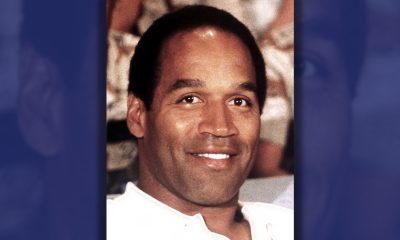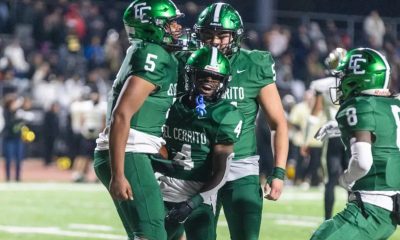Sports
Steelers Safety Troy Polamalu Retires

In this Oct. 7, 2012, file photo, Pittsburgh Steelers strong safety Troy Polamalu sits on the bench during an NFL football game against the Philadelphia Eagles in Pittsburgh. Polamalu’s iconic football career is over. The eight-time Pro Bowl safety told the Uniontown Herald-Standard he informed Steelers chairman Dan Rooney on Thursday night, April 9, 2015, he will retire rather than return for a 13th season. (AP Photo/Gene J. Puskar, File)
WILL GRAVES, AP Sports Writer
PITTSBURGH (AP) — His trademark locks bouncing off the top of his No. 43 jersey, Troy Polamalu spent more than a decade flying across football fields as the heady but humble backbone of a defense that led the Pittsburgh Steelers.
Now, his spectacular career belongs to the ages.
The eight-time Pro Bowler and 2010 NFL Defensive Player of the Year is retiring after 12 seasons, telling the only team he’s ever played for that it’s time for the next phase of his life. Polamalu’s retirement was first reported by the Uniontown (Pa.) Herald-Standard.
“Troy is a shining example of a football man in the way he loved the game, the way he respected the game and the way he played the game,” Steelers coach Mike Tomlin said in a statement. “It’s a shining example of the window into who he is. He is a legendary Steeler and a legendary man.”
Taken with the 16th overall pick in the 2003 NFL draft out of USC, Polamalu’s frenetic style and preternatural instincts allowed him to thrive in Hall of Fame defensive coordinator Dick LeBeau’s 3-4 defense. At his peak, Polamalu was arguably the most disruptive player in the league. His ability to anticipate what was coming became highlight fodder that will live on for generations, whether he was leaping over the line of scrimmage while trying to stuff a quarterback sneak or feathering his fingertips under the ball to pluck a pass before it struck the ground.
Still, beneath the hair that earned him a lucrative endorsement deal and the splash plays that changed the course of seasons — including a pick-six against Baltimore in the 2008 playoffs that paved the way for the team’s sixth Super Bowl title — was a man who defined himself as more than just a football player. He was open about his deep Christian faith and made the sign of the cross gesture following tackles.
Soft-spoken and thoughtful, Polamalu’s quiet nature away from the game played in stark contrast to the hell-bent way he went about his job. He embraced the role of mentor late in his career, taking expected successor Shamarko Thomas under his wing two years ago, even inviting Thomas to train with him on the west coast last spring, a regimen that Thomas joked was akin to learning how to be a ninja.
“His actions as a human being were just as impressive as any of the many inhuman plays he made on the football field,” Steelers general manager Kevin Colbert said. “We were very fortunate to have him be a part of our organization for the past 12 years.”
Polamalu finishes with 32 career interceptions, a dozen sacks, seven fumble recoveries and five touchdowns. The numbers, however, hardly do justice to the way Polamalu could wreak havoc on opposing game plans. LeBeau loved to say simply “Troy will be Troy” when asked how the Steelers might use Polamalu on a given Sunday.
While LeBeau’s system relied heavily on discipline and disguise, Polamalu was given expansive freedom to go where he felt the ball was headed. He was right more often than he was wrong. Yet his relentless play took a toll on his sturdy but hardly chiseled 5-foot-10, 213-pound frame. He played a full 16-game schedule just twice in his final six seasons, missing more than half of 2012 with calf problems and four games in 2014 following a fluky knee injury. Polamalu returned in time for Pittsburgh’s loss to Baltimore in the wild-card round of the playoffs, registering five tackles in what turned out to be his final game.
Polamalu, who had two years remaining on his contract with the Steelers, said in the aftermath of the loss he would have to wait and see what the future held.
Polamalu told the Herald-Standard he never considered playing for another team and decided it was time to move on when he wondered if he could make the commitment necessary to play another season.
His departure marks the third significant shake-up for a defense in transition during a busy offseason. LeBeau left in January after not having his contract renewed and free agent linebacker Jason Worilds abruptly retired in March at age 27.
LeBeau landed a job with Tennessee and Worilds is young enough that a comeback isn’t out of the question. Not so with Polamalu, who could become the first member of the core group that led the Steelers to two Super Bowl wins and three appearances in six seasons to be enshrined in the Pro Football Hall of Fame.
Tributes came pouring in through social media in the aftermath of Polamalu’s announcement, with opponents who spent long Sunday afternoons dreading dealing with Polamalu tipping their caps in reverence to an iconic career.
Tim Tebow tweeted Polamalu was one of the “toughest, smartest and kindest players I played against” while San Francisco wide receiver Torrey Smith — who tangled regularly with Polamalu while playing for the Ravens — tweeted “Polamalu would do some crazy things on the football field….loved watching him play and competing against him.”
It’s a feeling echoed by nearly all that witnessed Polamalu’s singular talent in person.
“We’ve been fortunate to have great players throughout the years, but he of course would be one of the top players,” Steelers chairman Dan Rooney said. “He did everything with dignity and responsibility, and it was special to have Troy be a Steeler his entire career.”
___
AP NFL website: www.pro32.ap.org and www.twitter.com/AP_NFL
Copyright 2015 The Associated Press. All rights reserved. This material may not be published, broadcast, rewritten or redistributed.
Business
Sacramento Kings and Black-Owned Digital License Plate Firm Enter History-Making Partnership
Reviver founder and Chief Strategy Officer Neville Boston attended the Sacramento Kings’ season opener at Golden 1 Center, witnessing players debut the company’s patch. Reviver proudly supports the Sacramento Kings’ community and diversity, equity, and inclusion initiatives. Photo by Antonio Ray Harvey, California Black Media (CBM).

By Antonio Ray Harvey, California Black Media
Reviver, the world’s first digital license plate and connected vehicle platform, has entered into a history-making jersey patch partnership with the Sacramento Kings, team officials announced right before the team’s season opener on Oct. 24.
The collaboration establishes Reviver as the first Black-founded technology jersey patch partner in the National Basketball Association (NBA).
The Reviver logo now appears on the left front strap of Kings’ uniforms.
Reviver founder and Chief Strategy Officer Neville Boston was in attendance to see the company’s patch worn by the Kings, during a game with the Minnesota Timberwolves at Golden 1 Center in downtown Sacramento.
“It was an absolutely amazing night. More than I ever expected,” Boston told California Black Media (CBM). “The Sacramento Kings have been incredible. On a national, and maybe a worldwide level, this partnership raises the profile of Reviver with the assistance of (Kings chairman and CEO) Vivek Ranadivé and the Kings.”
According to the Kings’ brass, Reviver, supported by the Black Star Fund, a Black-led venture capital firm based in Sacramento, is now an official “innovation partner” of the Kings and Golden 1 Center; a presenting partner of “Capitalize Technology,” a King’s corporate social investment initiative; and the exclusive digital license plate of the Sacramento Kings.
Headquartered in Granite Bay, a suburb of Sacramento, Reviver was born from a vision to modernize and streamline the vehicle registration renewal process. On Jan. 1, 2023, the state of California joined Georgia, Colorado, Michigan, and Arizona as states that have approved digital license plates for use statewide, after Reviver completed a four-year pilot program that evaluated a replacement for metal plates.
About 10,000 California drivers bought digital plates during the pilot program. Vehicles registered with the state are eligible to adopt the new high-tech tags. Reviver existence was made possible when Gov. Gavin Newsom signed Assembly Bill (AB) 984 in September 2022.
Under that law, California vehicle owners can update their titles, registrations, and other records remotely. In addition, the digital license “RPlate” includes a flashing message if a vehicle is reported stolen or if there is an Amber Alert.
Ranadivé is spreading the news that Reviver has international potential.
“This jersey patch partnership with Reviver continues the Kings long tradition of using our global platform to promote innovation and technology,” Ranadivé stated. “It’s particularly exciting to showcase a homegrown company that was part of our Kings Capitalize program. This is just the beginning of our work together, and we look forward to helping Reviver in its mission to modernize the driving experience.”
The commercial use of patches in professional basketball all began in 2009 when the Women’s Basketball Association (WNBA) Phoenix Mercury removed its name to replace it with sponsor, LifeLock, an identity-theft protection company. The landmark deal netted a contract worth about $1 million annually.
Kindra Montgomery-Block, vice president of diversity, equity, and social impact for the Sacramento Kings, was the integral facilitator who assisted Boston and his team in connecting with the sports franchise that is boasting 40 years in the Capital City.
“This partnership between the Kings and Reviver, backed by the Black Star Fund, will invest in the Sacramento community to promote technology and innovation in the region,” Montgomery-Block stated. “Reviver will support the Sacramento Kings community and diversity, equity, and inclusion initiatives.”
Editor’s Note: Neville Boston is a California Black Media board member.
Black History
Martial Artist Victor Moore: An American Karate and Kickboxing Pioneer
Throughout his career, Moore defeated many national champions, including Joe Lewis, Mike Stone, and Bill “Superfoot” Wallace. Moore placed in every tournament he competed in from 1965 until his retirement in 1975, defeating renowned national champions such as Mike Foster, Chuck Norris, Fred Wren, Glenn Keeney, James Hawkes, and Jim Kelly. Moore emphasizes that winning or losing does not diminish a champion’s credibility — they are all champions in his eyes.

By Tamara Shiloh
Victor Moore, born on Aug. 23, 1943, holds a 10th-degree Black Belt in Karate and is a four-time world karate champion.
As one of the chief instructors under Robert Trias in the Shuri-ryu Karate system, Moore was also among the first ten members of the Trias International Society. Over his 50-year martial arts career, he trained in various styles, including Chito-ryu with William J. Dometrich, Judo, Kempo, and Bondo karate.
Moore began his martial arts journey at the age of 7 in Cincinnati, lifting weights and reading Charles Atlas books to guide his training. By age 9, he had learned the basics of jujitsu and judo, and at 12, he began training in Kempo karate under Ronald Williams, who awarded him his first black belt after five years of instruction.
In 1961, Moore expanded his training by joining a judo school led by Ray Hughes and later trained in Gyu Ryu-karate under Harvey Eubanks. He studied Kempo with Bill Dometrich and continued exploring different karate styles. Instructors at the time, required students to start as white belts in each new style, even if they held black belts elsewhere, which shaped Moore’s adaptability.
Chung Ling, an exchange student from China, introduced Moore and others to Chuan Fa, enhancing Moore’s understanding of martial arts. He also took up judo at a school in Cincinnati, where he earned his brown belt, and trained in karate with Jim Wax, who had studied under the Shimabuku brothers. Moore’s toughness was further honed by his boxing experience at the 9th Street YMCA, where he became a sparring partner for Tiger Joe Harris.
At Central State University, Professor Barry Yasuto trained Moore in Shotokan karate, but Moore was denied entry to the Japanese Karate Association, possibly due to his race. After returning to Cincinnati, Moore opened his first karate school and began competing in national tournaments. He traveled across the U.S., eventually meeting Robert Trias, who became his mentor and helped him rise to the second-degree black belt level. Under Trias, Moore continued training in Kempo and Goju-Ryu styles.
Moore also trained under Dr. Maung Gyi, learning Bondo karate, stick fighting, and kickboxing. In 1973, Moore and Joe Lewis introduced kickboxing to America on the Merv Griffin TV show. Moore competed in the first kickboxing tournament in the U.S., facing Jim Harrison in a historic fight.
Throughout his career, Moore defeated many national champions, including Joe Lewis, Mike Stone, and Bill “Superfoot” Wallace. Moore placed in every tournament he competed in from 1965 until his retirement in 1975, defeating renowned national champions such as Mike Foster, Chuck Norris, Fred Wren, Glenn Keeney, James Hawkes, and Jim Kelly. Moore emphasizes that winning or losing does not diminish a champion’s credibility — they are all champions in his eyes.
Moore continues to teach martial arts, working with instructors and students nationwide. His daughters, Vickie and Vonnie, and his son, Vanceston, also train under his guidance.
Bay Area
Cal State East Bay Athletic Department Holds Hall of Fame Gala
The university honored exceptional athletes, teams, and coaches at their annual celebration before 200 guests. The Class of 2024 included the 1999-2000 Pioneer Softball Team that won the Cal Pac Championship in 2000 and went on to win the first two games of the NAIA Region II Playoffs and combined 32-3 in CalPac over the two seasons.

By Carla Thomas
California State University East Bay Athletics (CSUEB) hosted their 2024 Pioneer Hall of Fame Gala at the Pioneer Gymnasium in Hayward on Saturday, Oct. 19.
The university honored exceptional athletes, teams, and coaches at their annual celebration before 200 guests.
The Class of 2024 included the 1999-2000 Pioneer Softball Team that won the Cal Pac Championship in 2000 and went on to win the first two games of the NAIA Region II Playoffs and combined 32-3 in CalPac over the two seasons.
The 1999 CalPac Player of the Year was Pioneer Hall-of-Famer Danielle Stines and also on the 1999 team was Pioneer Hall-of-Famer Angel Alcorcha.
In 2000, the Pioneers swept the premier CalPac Awards, and Rachel Abrams was named Player of the Year, Christy Smith was named Pitcher of the Year, and Karen Lee Yoder (Matteson) was named Coach of the Year. Their team record for batting average in 1999 still stands after 25 years with an amazing combined .347.
Lorenzo Hall of CSUEB’s Men’s Basketball Team 1986-1990 was recognized for his achievements as a two-time All-NCAC selection, ranking in the top-10 in program history for assists, steals, free throw percentage and scoring.
At the time of his graduation, Hall held NCAC records for assists and steals. He also served as an assistant coach for the Pioneers after his playing career and created the nonprofit First Step Basketball to guide the next generation of young athletes.
Inductee and Women’s Gymnastics Coach Dorie Krepton of 1971-1985 led the team through winning 145 of 171 meets, 84% of their competition.
Through her 14 years of leading the Pioneers, Krepton coached the program to five Golden Gate Conference Championships, and the team qualified and participated in six NCAA Gymnastics National Championships. She also coached 10 All-American Athletes, including Pioneer Hall of Famers Holly Moore Leonard and Janet Kramer.
The seven-time Coach of the Year honoree served as Kinesiology and Physical Education professor emeritus at Cal State East Bay, which offered a degree option in exercise nutrition in the Kinesiology Department.
Bob Olsen of the CSUEB Men’s Track and Field Team, 1976-1979, was a member of 1977 NCAA Division II National Championship team and the two-time Far Western Conference Champion in pole vault, 1978 and 1979. Olsen was a four-time All-Conference selection and in 1976, Olsen became the first freshman pole vaulter in Division II to clear 16 feet.
Olsen was in the top 10 in the pole vault at the NCAA Division II Championships four times in his career.
Honoree Kulwant Singh served as the men’s and women’s assistant soccer coach from 1983-1990. The women’s team won six straight conference championships from 1984 to 1989. Singh served on the coaching staff alongside Pioneer Hall of Famer Colin Lindores.
In 1985, Singh coached the women’s team to an undefeated regular season (18-0) and lost to UC Santa Barbara on a golden goal in the NCAA playoffs. Singh was assistant coach for the 1988 NCAA Division II Women’s Soccer Championship team and helped the 1989 men’s soccer team reach the NCAA Division II Championship semifinals.
Singh also played on the pitch as a Pioneer before coaching in Hayward and currently serves as commissioner for the Central Valley Conference.
The inductees also participated in several days of alumni activity, beginning with Pioneer Alumni Day on Thursday, Oct. 17.
With the addition of the new members, the Pioneers Hall of Fame now features 119 individuals and four teams.
During sports seasons, the Pioneer Gymnasium is open to the public, and guests can view the school’s Hall of Fame Wall.
-

 Alameda County3 weeks ago
Alameda County3 weeks agoAlameda County District Attorney Pamela Price Announces $7.5 Million Settlement Agreement with Walmart
-

 Activism2 weeks ago
Activism2 weeks ago‘Jim Crow Was and Remains Real in Alameda County (and) It Is What We Are Challenging and Trying to Fix Every Day,’ Says D.A. Pamela Price
-

 Bay Area3 weeks ago
Bay Area3 weeks agoIn the City Attorney Race, Ryan Richardson Is Better for Oakland
-

 Activism2 weeks ago
Activism2 weeks agoOakland Post: Week of October 30 – November 5, 2024
-

 Business4 weeks ago
Business4 weeks agoHarris Promises 1 Million Forgivable Loans for Black Businesses
-

 Business4 weeks ago
Business4 weeks agoStudy Confirms California’s $20/Hour Fast Food Wage Raises Pay Without Job Losses
-

 Activism3 weeks ago
Activism3 weeks ago“Two things can be true at once.” An Afro-Latina Voter Weighs in on Identity and Politics
-

 Arts and Culture3 weeks ago
Arts and Culture3 weeks agoMacArthur Fellow Jericho Brown’s Poetry Reflects Contemporary Culture and Identity






















































